A Mathematical Model of Gas and Water Flow in a Swelling Geomaterial—Part 2. Process Simulation
Abstract
1. Introduction
2. Mathematical Model
2.1. Study Overview
- heterogeneity through the use of a random normal distribution of porosity;
- Klinkenberg “slip flow” effect for the intrinsic permeability of the gas in soil;
- a swelling strain to take into account volume changes of the geomaterial with suction.
2.2. Governing Equations for Two-Phase Flow through a Linear Elastic Geomaterial
2.2.1. Conservation of Water Mass
2.2.2. Conservation of Gas Mass
2.2.3. Conservation of Momentum (Quasi-Static Equilibrium)
2.3. Intrinsic Permeability and the Klinkenberg Effect “Slip Flow”
2.4. Swelling Strain Component
3. Process Simulation and Enhanced Two-Phase Flow Analysis Study
3.1. Numerical Model Description
3.1.1. Overview of the Numerical Model
3.1.2. Model Geometry and Mesh
3.1.3. Material Properties
3.1.4. Initial Value Condition
3.1.5. Boundary Conditions
Gas Conservation BCs
Water Conservation BCs
Momentum Conservation BCs
3.2. Modelling Approach
- immobile liquid phase
- no dissolution of gas into and no diffusion gas through the porewater
- constant gas permeability
- constant gas density
- constant degree of saturation of water
- role of suction ignored
- role of gravity ignored
- isothermal process
- constant volume boundary condition
3.3. Implementation of Enhanced Mechanisms for Two-Phase Flow
3.3.1. Introduction of Heterogeneity
3.3.2. Klinkenberg “Slip Flow” Effect–Intrinsic Permeability of Gas
3.3.3. Coefficient of Swelling Strain
3.4. Results and Discussion
- poregas pressure evolution through the specimen
- gas inflow/outflow
- gas storage in the system
- total stress evolution
3.4.1. Poregas Pressure Evolution through the Specimen
3.4.2. Gas Inflow and Outflow
3.4.3. Gas Storage in the System
3.4.4. Evolution of Total Stresses
3.5. Additional Factors
3.5.1. Mesh Dependency, Time Stepping, and Relative Tolerance
3.5.2. Extent of Heterogeneity
4. Discussion and Conclusions
Author Contributions
Funding
Acknowledgments
Conflicts of Interest
References
- Low-Level Radioactive Waste Management Office. Inventory of Radioactive Waste in Canada; Low-Level Radioactive Waste Management Office: Ottawa, ON, Canada, 2012. [Google Scholar]
- CNSC. Regulatory Guide G-320, Assessing the Long Term Safety of Radioactive Waste Management; CNSC: Ottawa, ON, Canada, 2006. [Google Scholar]
- Norris, S. EC FORGE Project: Updated Consideration of Gas Generation and Migration in the Safety Case. In Gas Generation and Migration in Deep Geological Radioactive Waste Repositories; Special Publications; Shaw, R.P., Ed.; Geological Society: London, UK, 2015; Volume 415, pp. 241–258. [Google Scholar]
- Shaw, R.P. The Fate of Repository Gases (FORGE) project. In Gas Generation and Migration in Deep Geological Radioactive Waste Repositories; Special Publications; Shaw, R.P., Ed.; Geological Society: London, UK, 2015; Volume 415, pp. 1–7. [Google Scholar]
- Cuss, R.; Harrington, J.; Giot, R.; Auvray, C. Experimental observations of mechanical dilation at the onset of gas flow in Callovo-Oxfordian claystone. In Clays in Natural and Engineered Barriers for Radioactive Waste Confinement; Norris, S., Bruno, J., Cathelineau, M., Delage, P., Fairhurst, C., Gaucher, E.C., Höhn, E.H., Klinichev, A., Lalieux, P., Sellin, P., Eds.; Geological Society: London, UK, 2014; Volume 400, pp. 507–519. [Google Scholar]
- Ahusborde, E.; Amaziane, B.; Jurak, M. Three-dimensional numerical simulation by upscaling of gas migration through engineered and geological barriers for a deep repository for radioactive waste. In Gas Generation and Migration in Deep Geological Radioactive Waste Repositories; Special Publications; Shaw, R.P., Ed.; Geological Society: London, UK, 2015; Volume 415, pp. 123–141. [Google Scholar]
- Horseman, S.T.; Harrington, J.F.; Sellin, P. Gas migration in clay barriers. Eng. Geol. 1999, 54, 139–149. [Google Scholar] [CrossRef]
- Sellin, P.; Leupin, O.X. The use of Clay as an Engineered Barrier in Radioactive-Waste Management—A Review. Clays Clay Miner. 2013, 61, 477–498. [Google Scholar] [CrossRef]
- Sellin, P. Experiments and Modelling on the behaviour of EBS. FORGE Rep. D 2014, 3, 38. [Google Scholar]
- Marschall, P.; Horseman, S.; Gimmi, T. Characterisation of Gas Transport Properties of the Opalinus Clay, a Potential Host Rock Formation for Radioactive Waste Disposal. Oil Gas Sci. Technol. Rev. IFP 2005, 60, 121–139. [Google Scholar] [CrossRef]
- Dagher, E.E.; Nguyen, T.S.; Infante Sedano, J.A. Development of a mathematical model for gas migration (two-phase flow) in natural and engineered barriers for radioactive waste disposal. In Multiple Roles of Clays in Radioactive Waste Confinement; Special Publications; Norris, S., Neeft, E., Van Geet, M., Eds.; Geological Society: London, UK, 2018. [Google Scholar]
- Nash, P.J.; Swift, B.T.; Goodfield, M.; Rodwell, W.R. Modelling Gas Migration in Compacted Bentonite: A Report Produced for the GAMBIT Club; POSIVA: Helsinki, Finland, 1998. [Google Scholar]
- Hoch, A.R.; Cliffe, K.A.; Swift, B.T.; Rodwell, W.R. Modelling Gas Migration in Compacted Bentonite: GAMBIT Club Phase 3 Final Report; POSIVA: Olkiluoto, Finland, 2004. [Google Scholar]
- Fall, M.; Nasir, O.; Nguyen, T. A coupled hydro-mechanical model for simulation of gas migration in host sedimentary rocks for nuclear waste repositories. Eng. Geol. 2014, 176, 24–44. [Google Scholar] [CrossRef]
- Harrington, J.F.; Horseman, S.T. Gas transport properties of clays and mudrocks. In Muds and Mudstones: Physical and Fluid Flow Properties; Aplin, A.C., Fleet, A.J., MacQuaker, J.H., Eds.; The Geological Society of London: London, UK, 1999; Volume 158, pp. 107–124. [Google Scholar]
- Horseman, S.T.; Harrington, J.F.; Sellin, P. Water and Gas Movement in Mx80 Bentonite Buffer Clay. Symposium on the Scientific Basis for Nuclear Waste Management XXVII (Kalmar). Mater. Res. Soc. 2003, 807, 715–720. [Google Scholar] [CrossRef]
- Harrington, J.F.; de la Vaissiére, R.; Noy, D.J.; Cuss, R.J.; Talandier, J. Gas flow in Callovo-Oxfordian claystone (COx): Results from laboratory and field-scale measurements. Mineral. Mag. 2012, 76, 3303–3318. [Google Scholar] [CrossRef]
- Graham, C.C.; Harrington, J.F.; Cuss, R.J.; Sellin, P. Gas migration experiments in bentonite: Implications for numerical modelling. Mineral. Mag. 2012, 76, 3279–3292. [Google Scholar] [CrossRef]
- Bennett, D.P.; Cuss, R.J.; Vardon, P.J.; Harrington, J.F.; Sedighi, M.; Thomas, H.R. Exploratory data analysis of the Large Scale Gas Injection Test (Lasgit) dataset, focusing on’second-order’ events around macro-scale gas flows. In Gas Generation and Migration in Deep Geological Radioactive Waste Repositories; Special Publications; Shaw, R.P., Ed.; Geological Society: London, UK, 2015; Volume 415, pp. 225–239. [Google Scholar]
- Davis, R.O.; Selvadurai, A.P. Plasticity and Geomechanics; Cambridge University Press: Cambridge, UK, 2002. [Google Scholar]
- Sahimi, M.; Rasaei, M.R.; Haghighi, M. Gas Injection and Fingering in Porous Media. In Theory and Applications of Transport in Porous Media Volume 20: Gas Transport in Porous Media; Ho, C.K., Webb, S.W., Eds.; Springer: Dorderecht, The Netherlands, 2006; pp. 133–168. [Google Scholar]
- Blunt, M.; Christie, M. How to Predict Viscous Fingering in Three Component Flow. Transp. Porous Media 1993, 12, 207–236. [Google Scholar] [CrossRef]
- Moortgat, J. Viscous and Gravitational Fingering in Multiphase Compositional and Compressible Flow. Adv. Water Resour. 2016, 89, 53–66. [Google Scholar] [CrossRef]
- Nguyen, T.; Le, A. Simultaneous gas and water flow in a damage-susceptible bedded argillaceous rock. Can. Geotech. J. 2015, 52, 18–32. [Google Scholar] [CrossRef]
- Dagher, E.E.; Infante Sedano, J.A.; Nguyen, T.S. A Mathematical Model of Gas and Water Flow in a Swelling Geomaterial—Part 1. Verification with Analytical Solution. Minerals 2019, in press. [Google Scholar]
- Khalili, N.; Khabbaz, M.H. A unique relatiship for χ for the determination of the shear strength of unsaturated soils. Géotechnique 1998, 48, 681–687. [Google Scholar] [CrossRef]
- Pall, R.; Moshenin, N.N. Permeability of Porous Media as a Function of Porosity and Particle Size Distribution. Trans. ASAE 1980, 23, 742–745. [Google Scholar] [CrossRef]
- Wibberley, C.A. Hydraulic diffusivity of fault gouge zones and implications for thermal pressurization during seismic slip. Earth Planets Space 2002, 54, 1153–1171. [Google Scholar] [CrossRef]
- Noda, H.; Shimamoto, T. Thermal pressurization and slip-weakening distance of a fault; an example of Hanoare Fault, southwest Japan. Bull. Seismol. Soc. Am. 2005, 95, 1224–1233. [Google Scholar] [CrossRef]
- Wibberley, C.A.; Shimamoto, T. Earthquake slip weakening and asperities explained by thermal pressurization. Nature 2005, 436, 689–692. [Google Scholar] [CrossRef]
- Klinkenberg, L.J. The permeability of Porous Media to Liquids and Gases; Drilling and Productions Practices; American Petroleum Institute: Washington, DC, USA, 1941; pp. 200–213. [Google Scholar]
- Nasir, O.; Nguyen, T.S.; Barnichon, J.D.; Millard, A. Simulation of hydromechanical behaviour of benotointe seals for containment of radioactive wastes. Can. Geotech. J. 2017, 54, 1055–1070. [Google Scholar] [CrossRef]
- Daniels, K.A.; Harrington, J.F. The response of compact bentonite during a 1D gas flow test, British Geological Survey Open Report, OR/17/067. Br. Geol. Surv. 2017. [Google Scholar]
- Ho, C.K.; Webb, S.W. Gas Transport in Porous Media; Springer: Dordrecht, The Netherlands, 2006. [Google Scholar]
- Jones, F.O.; Owens, W.W. A laboratory study of low permeaability gas sands. J. Pet. Technol. 1980, 32, 1631–1640. [Google Scholar] [CrossRef]
- Zhu, W.C.; Liu, J.; Sheng, J.C.; Elsworth, D. Analysis of coupled gas flow and deformation process with desorption and Klinkenberg effects in coal seams. Int. J. Rock Mech. Min. Sci. 2007, 44, 971–980. [Google Scholar] [CrossRef]
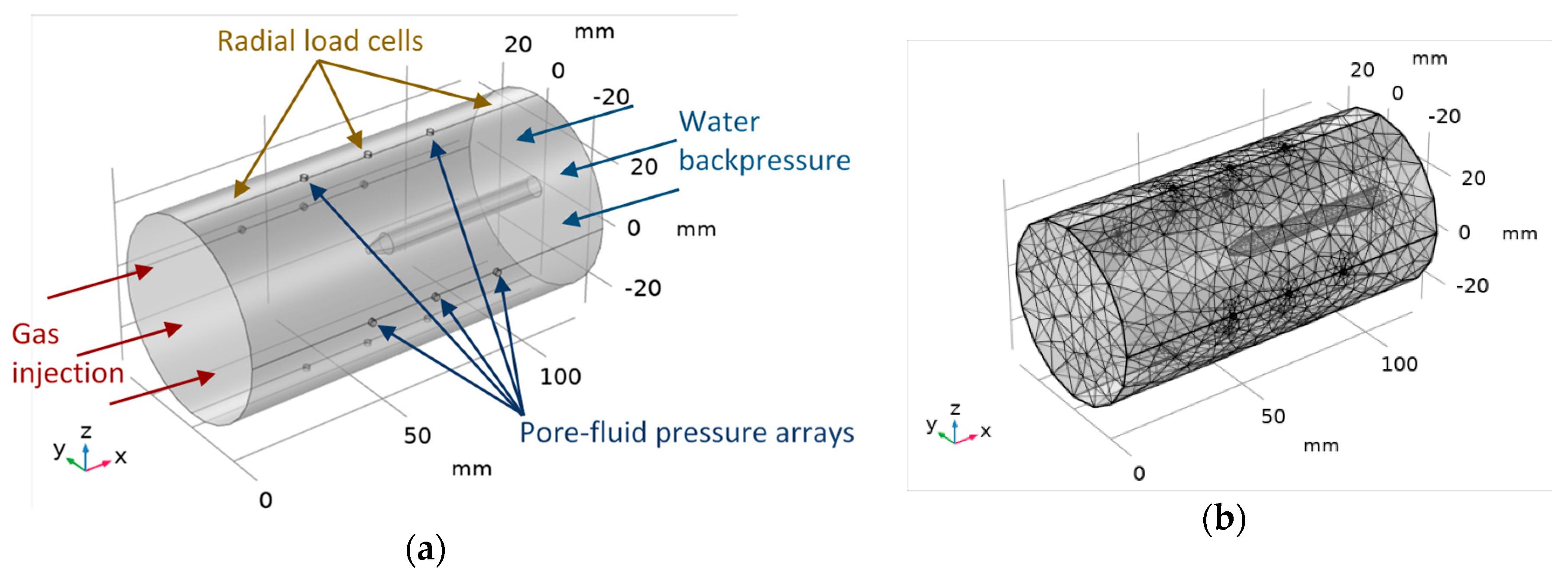
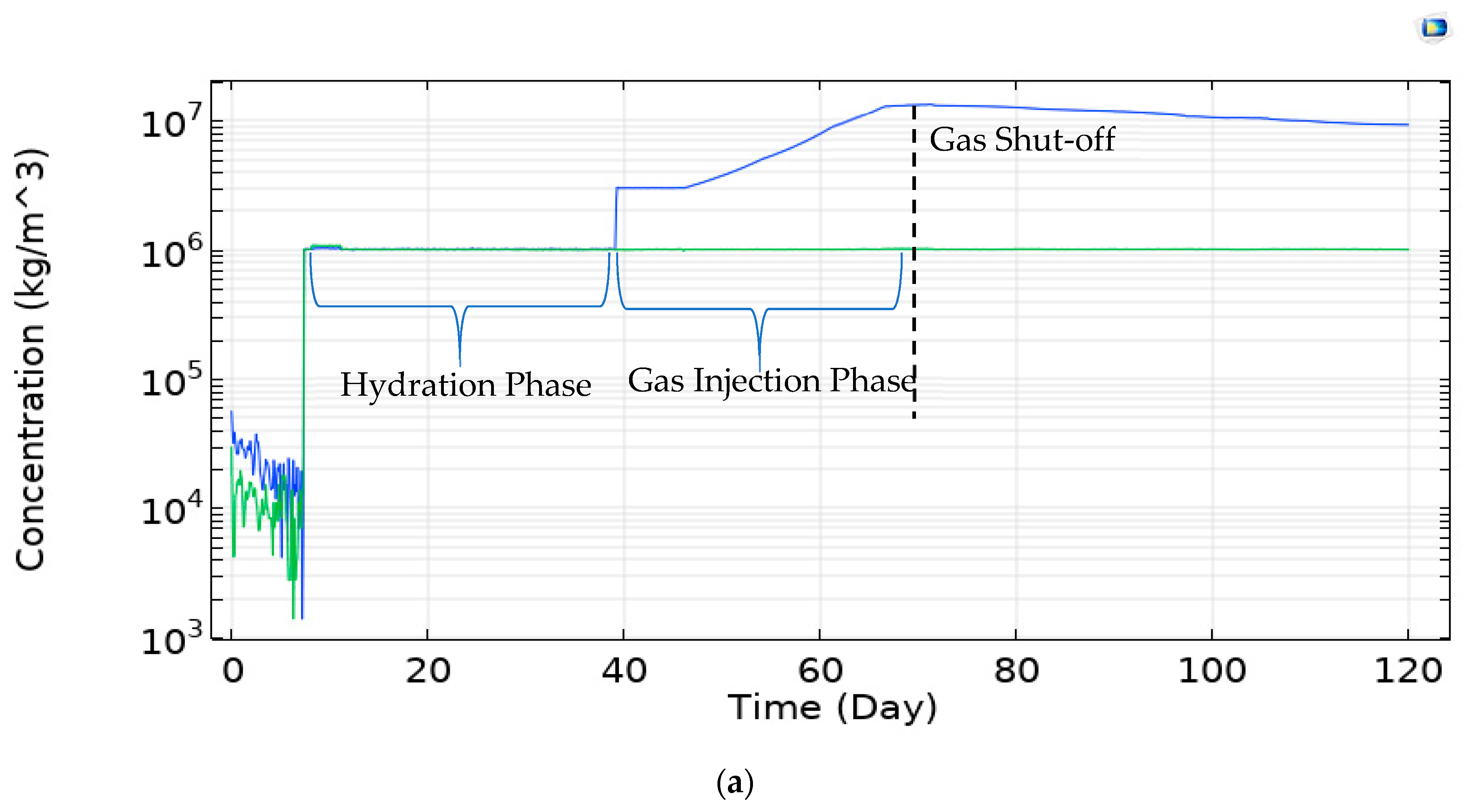
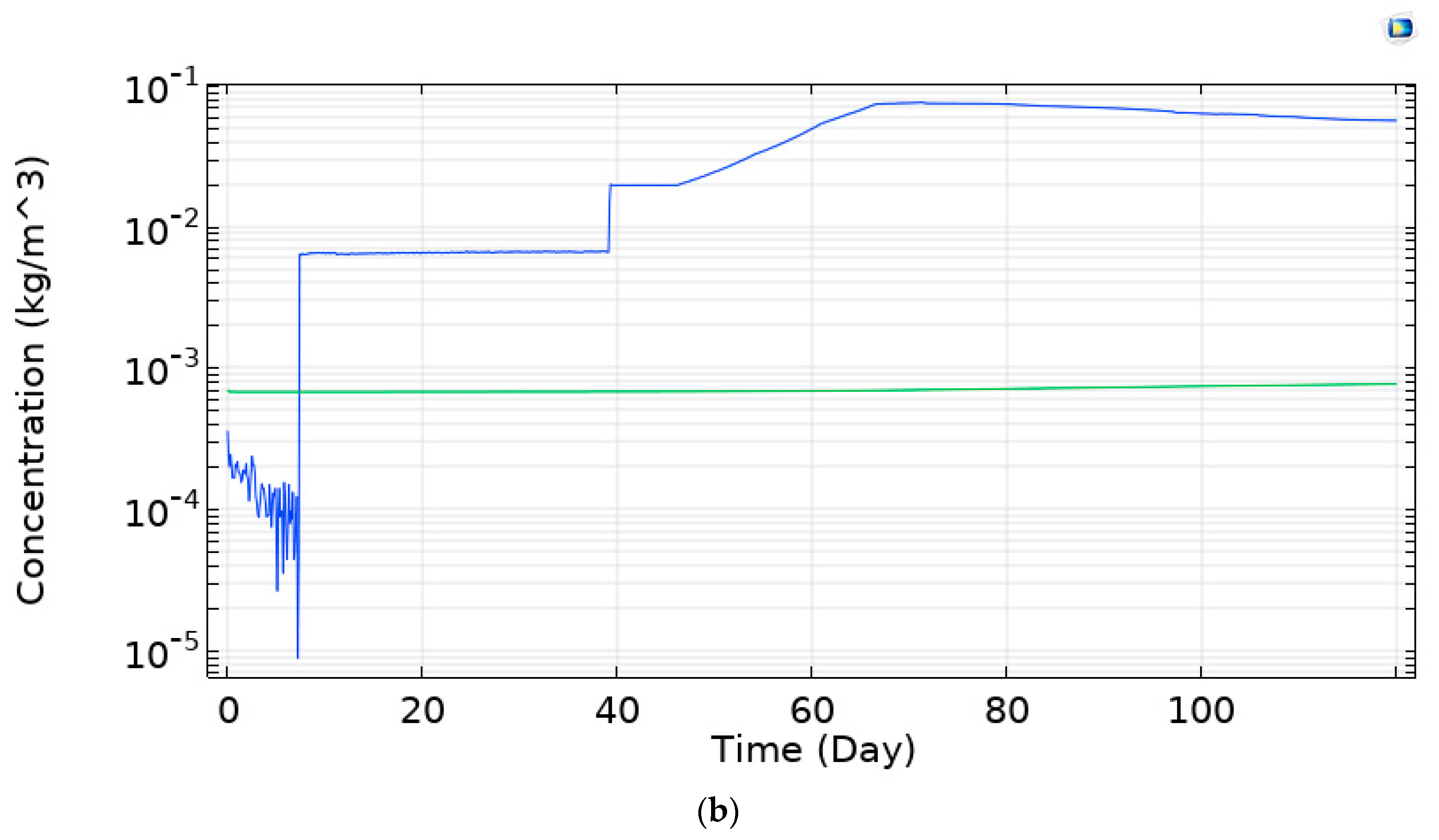
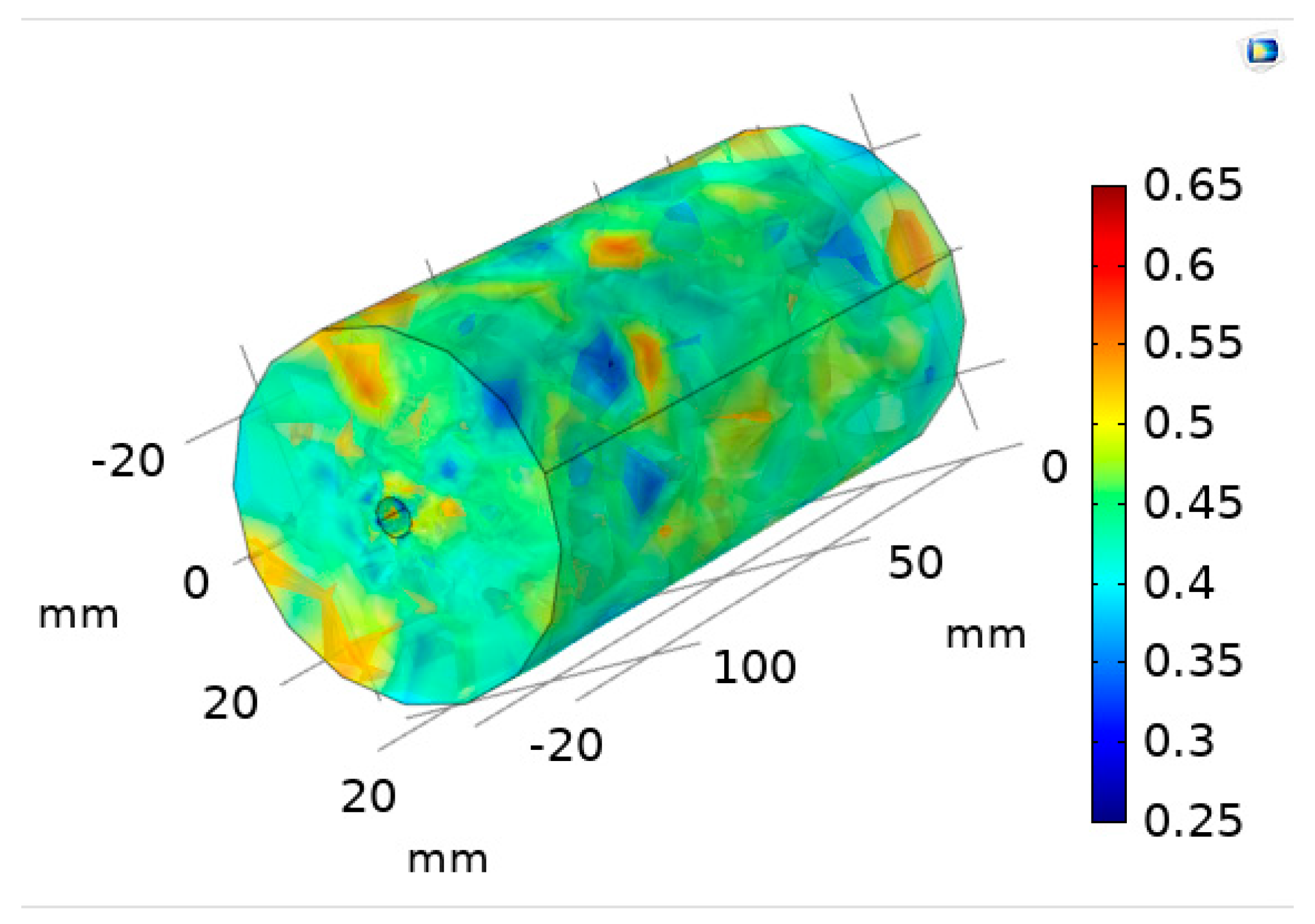
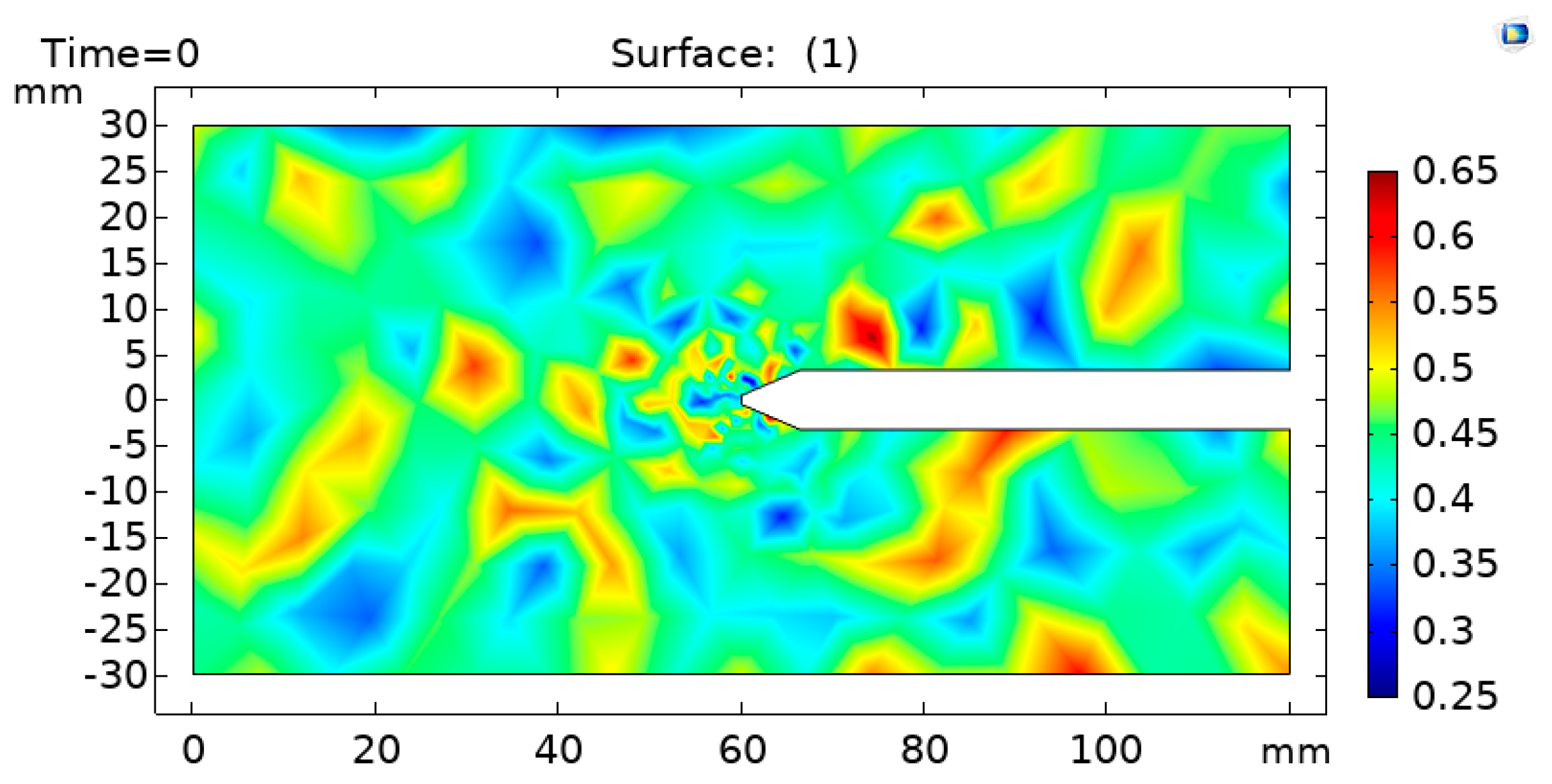
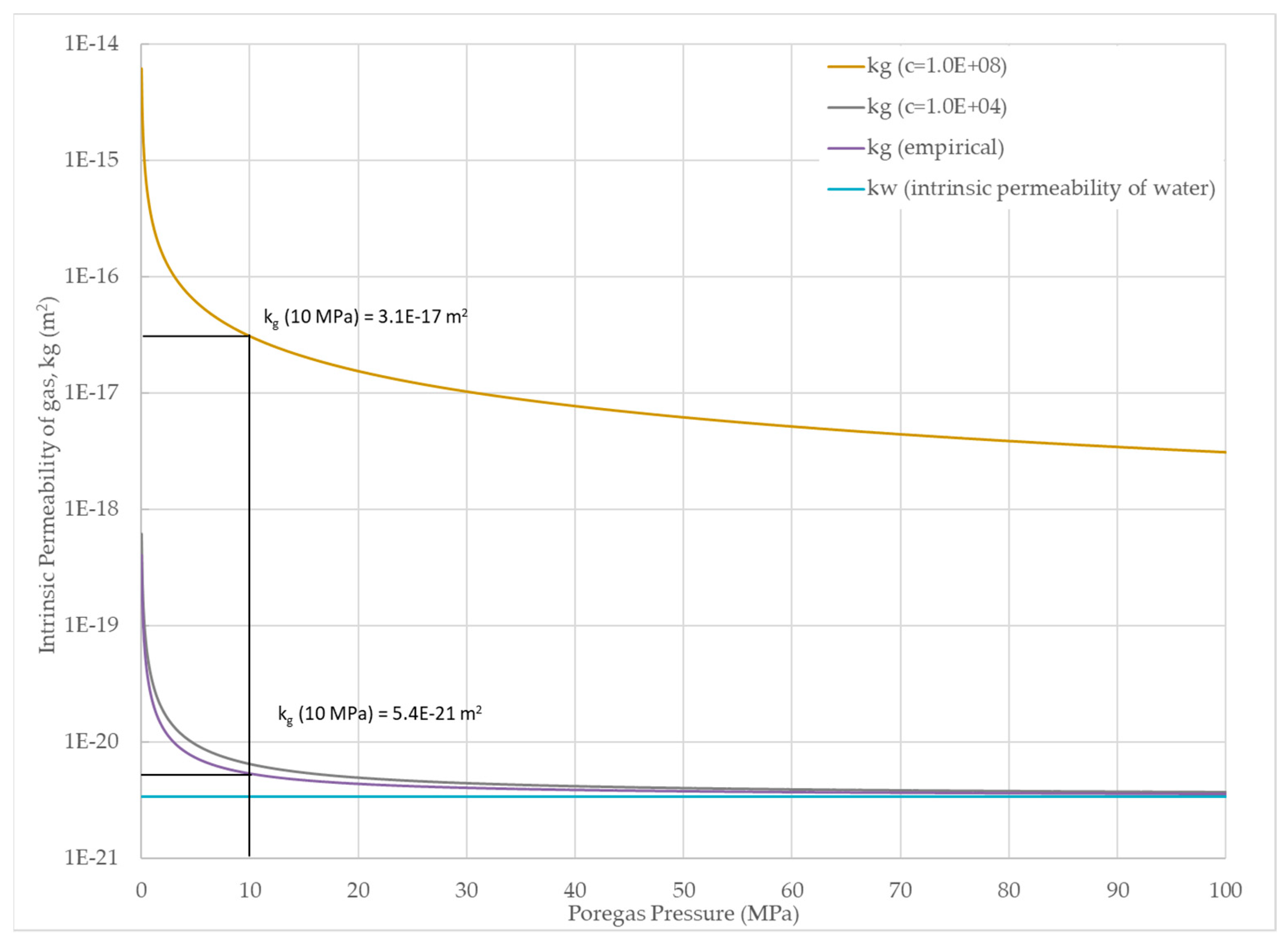
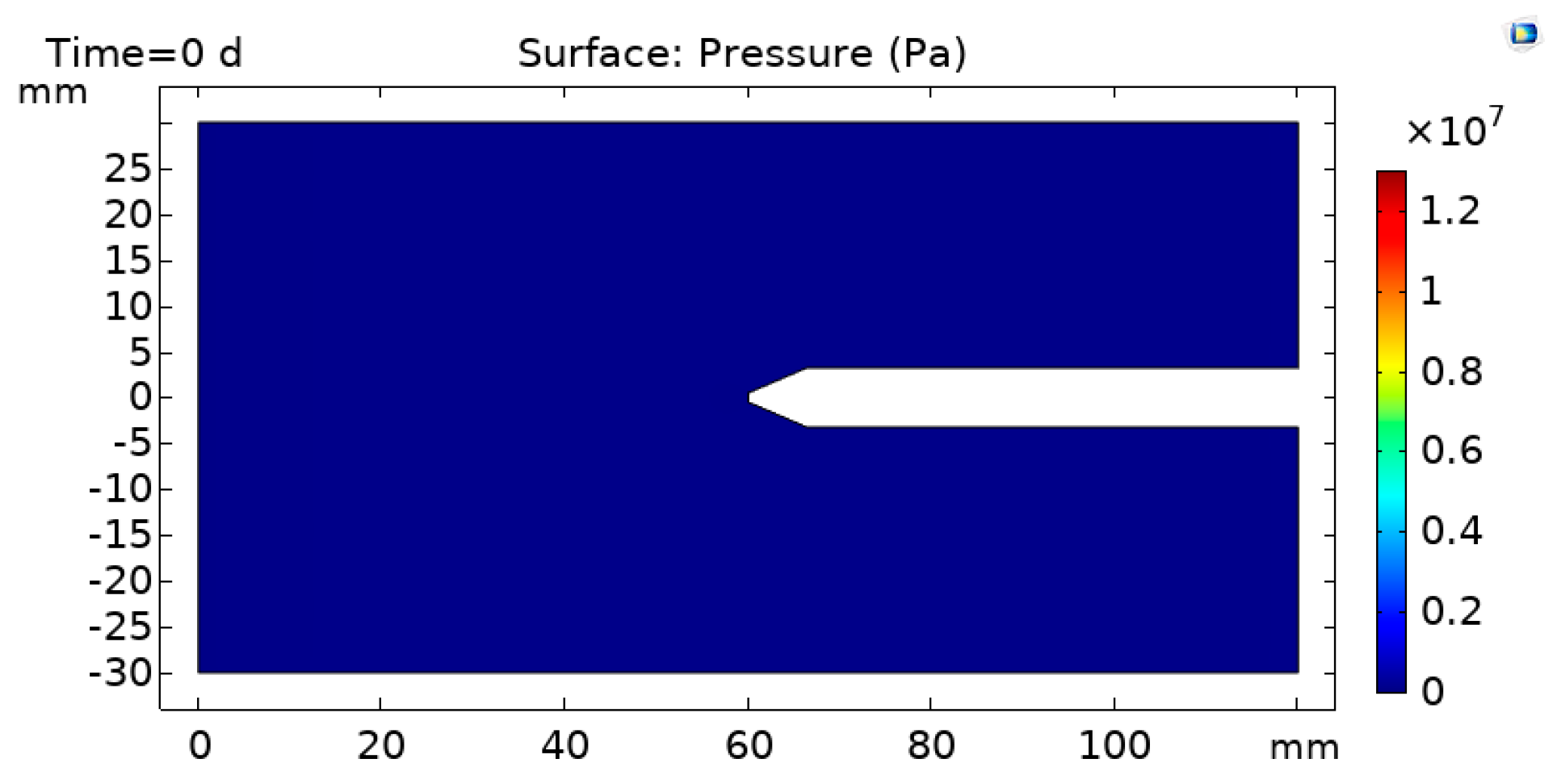
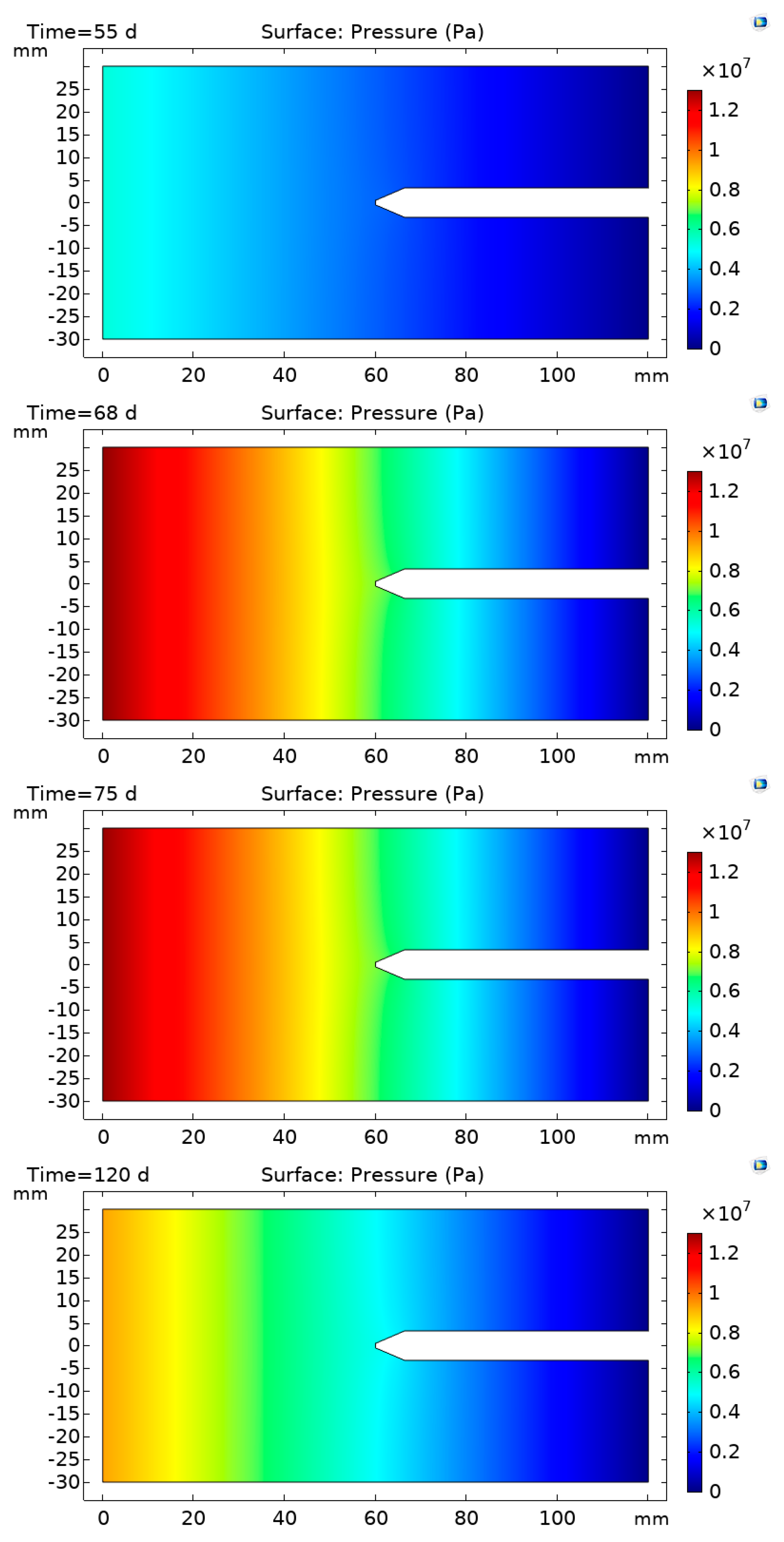
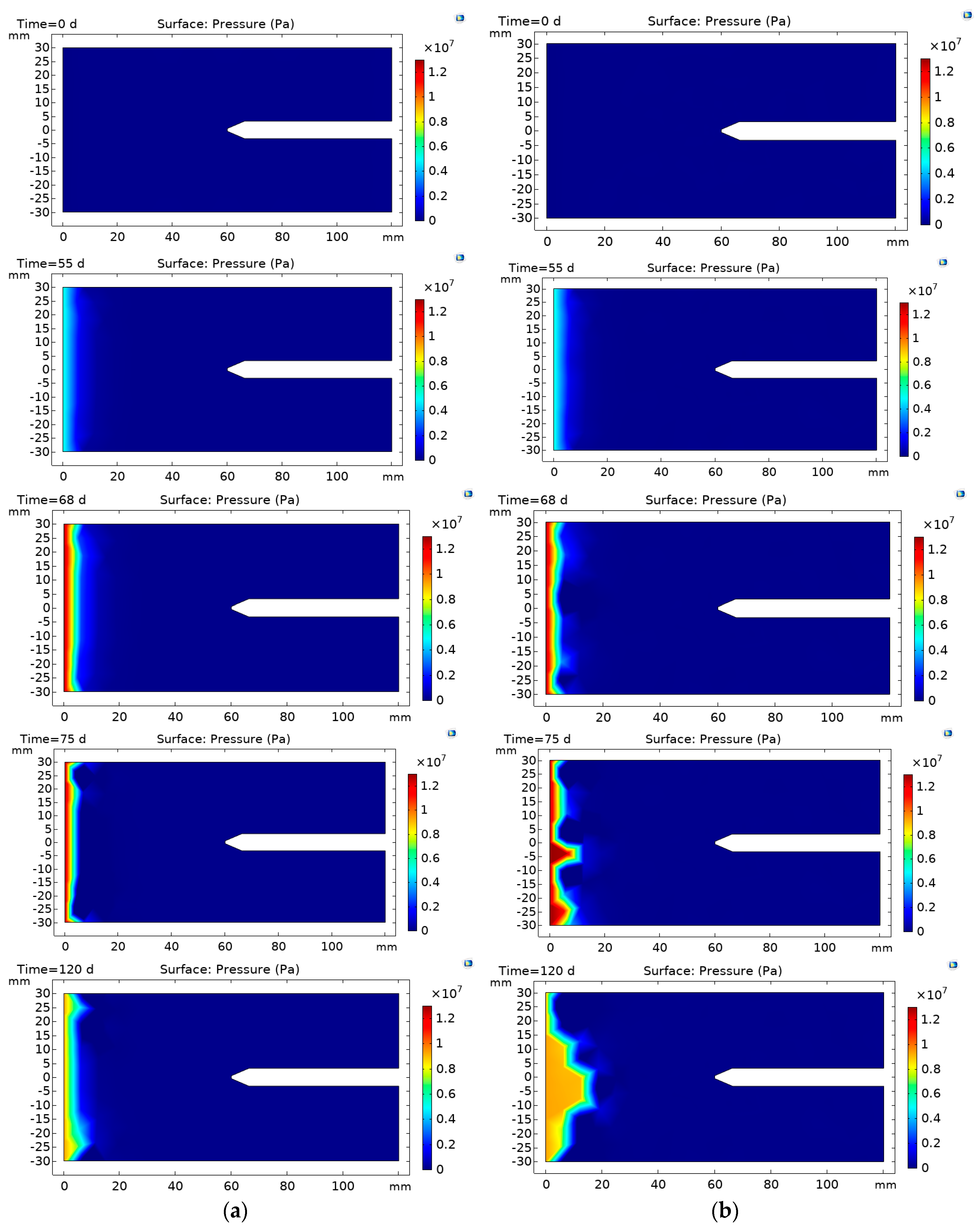
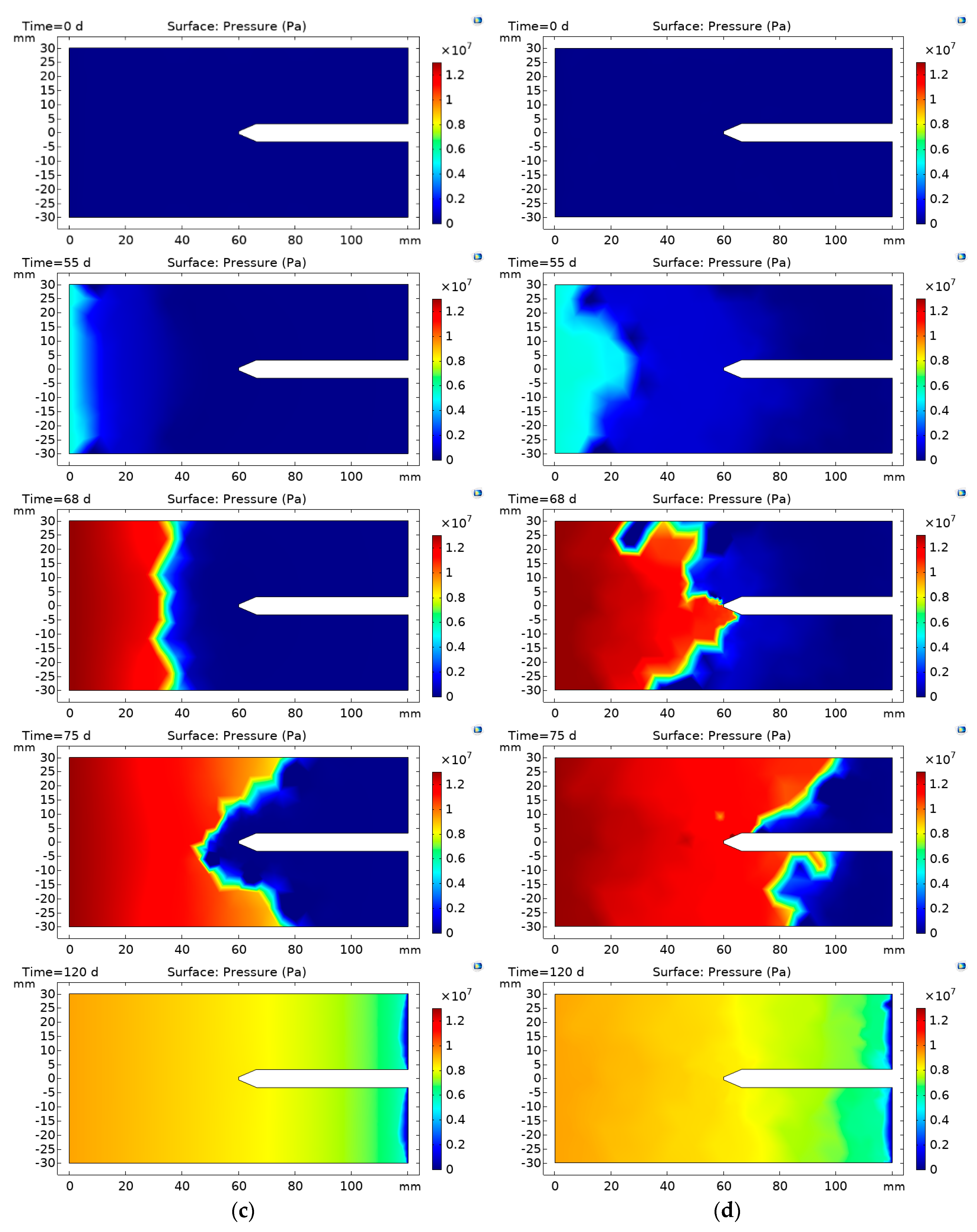
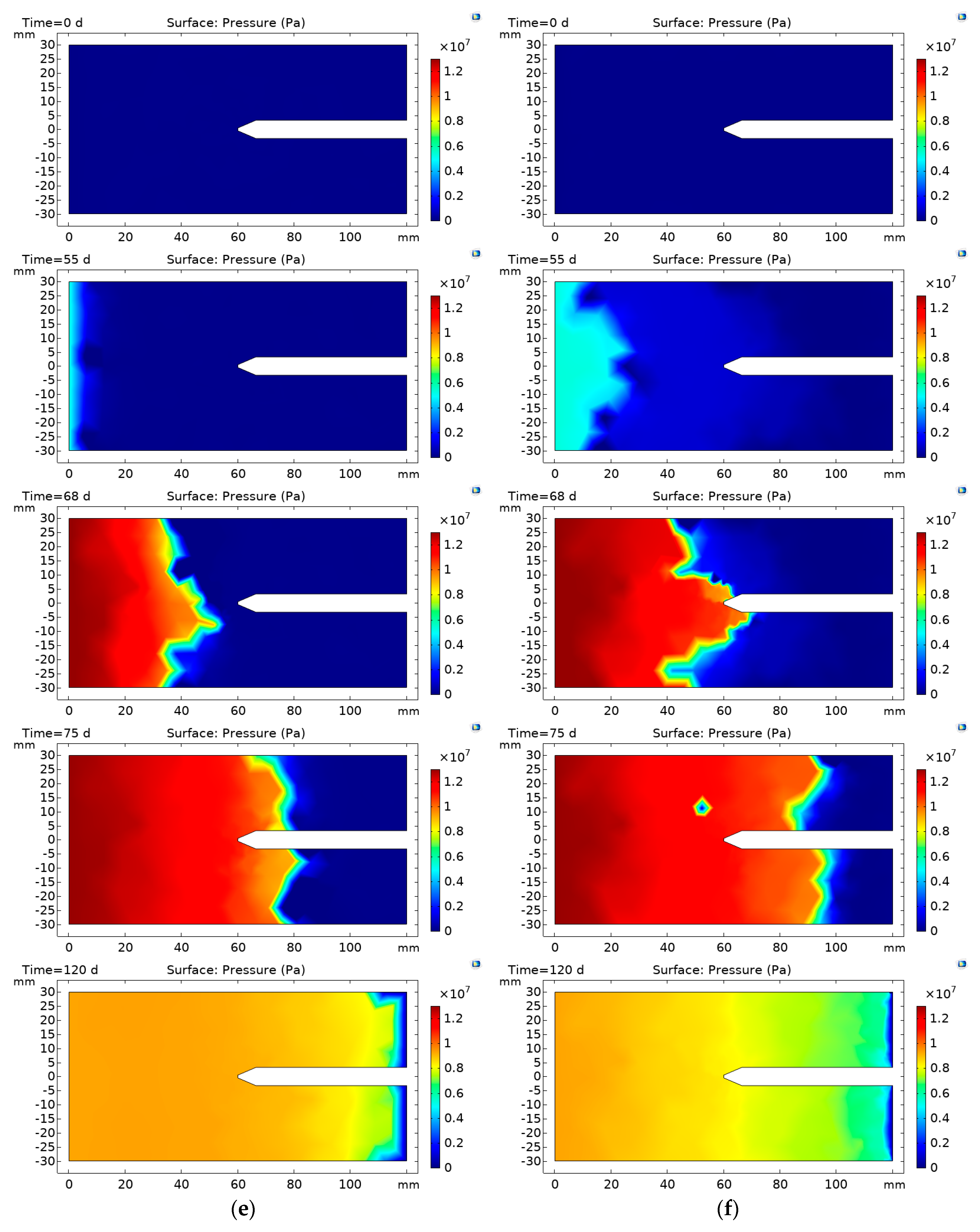
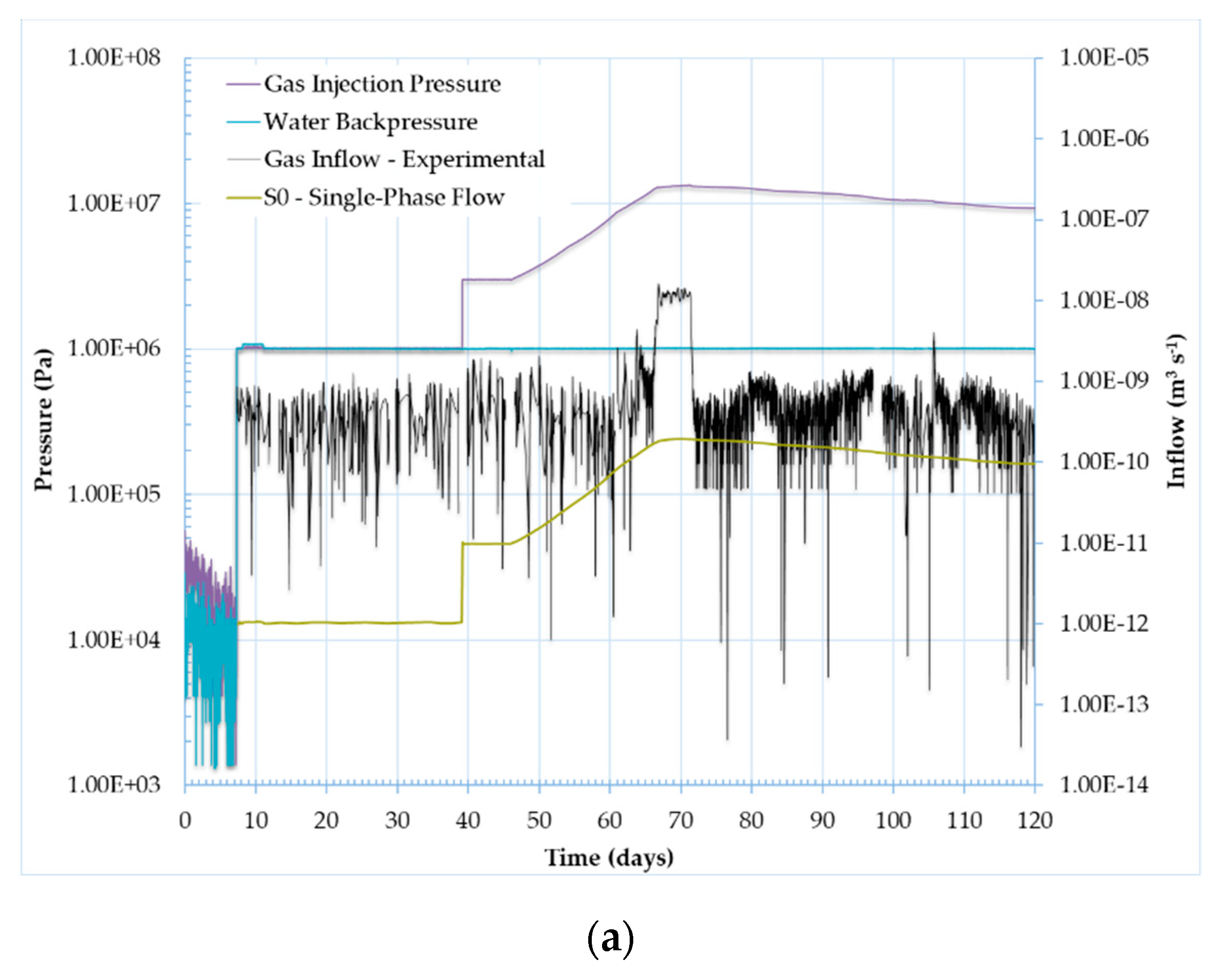
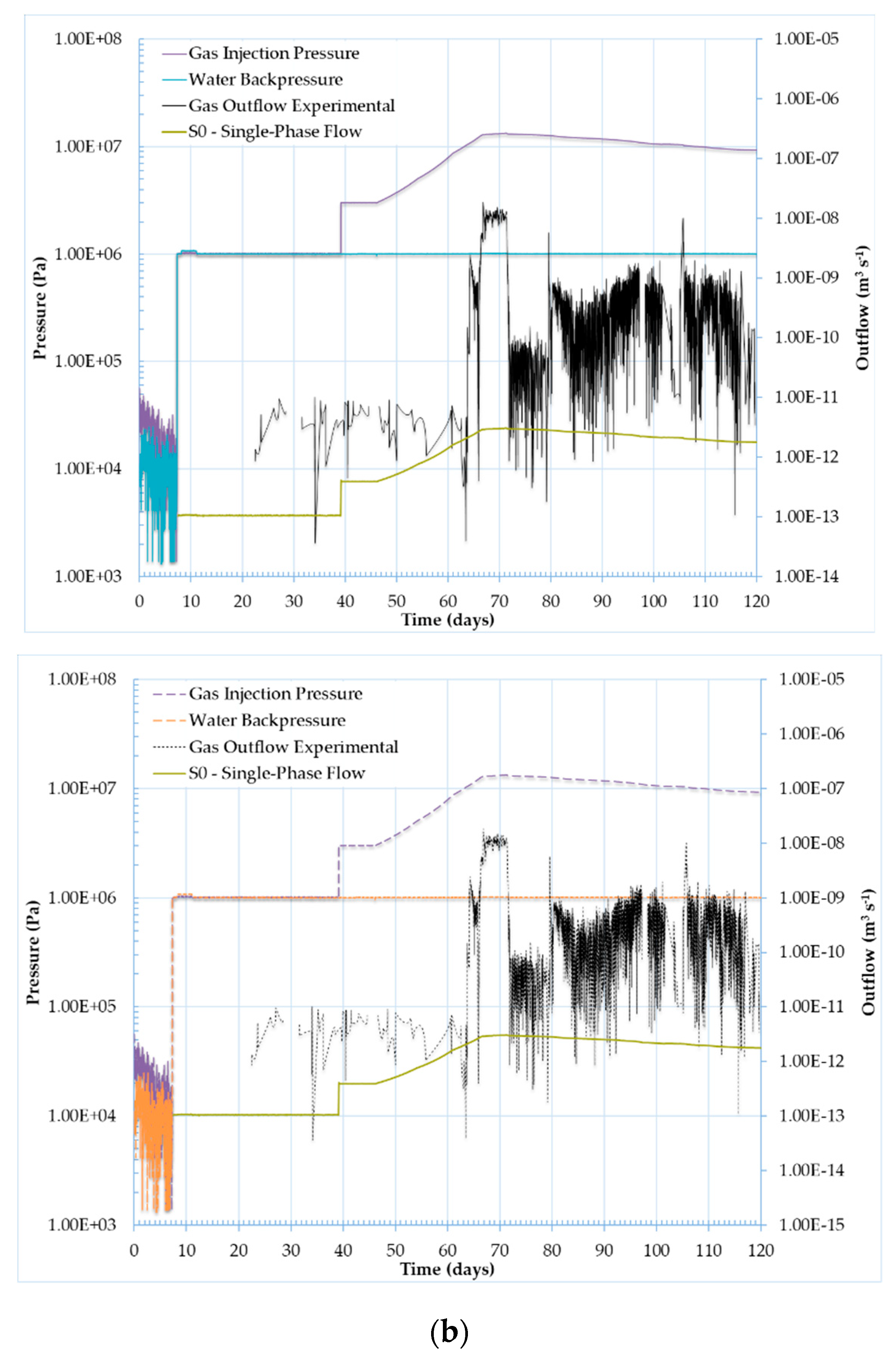
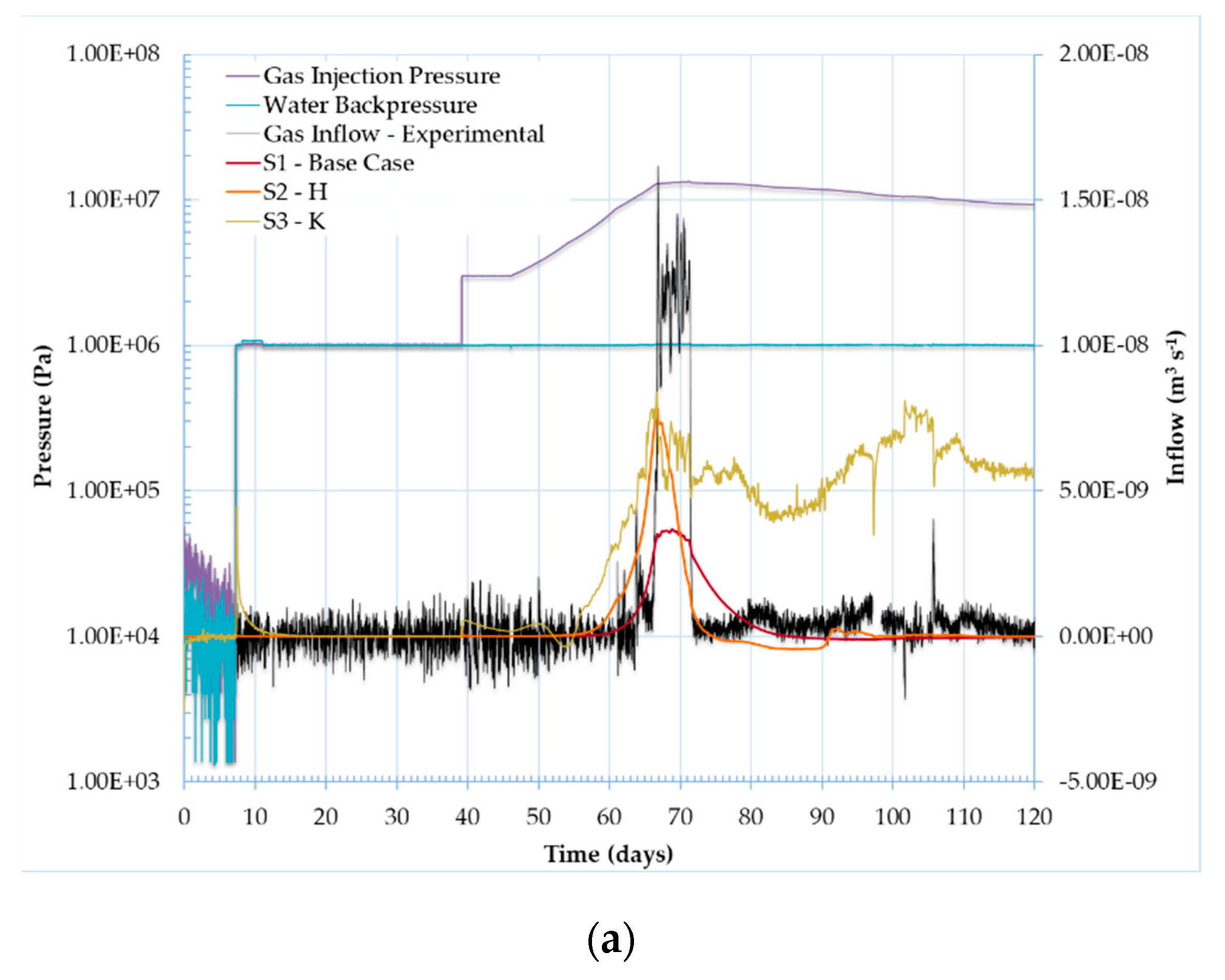
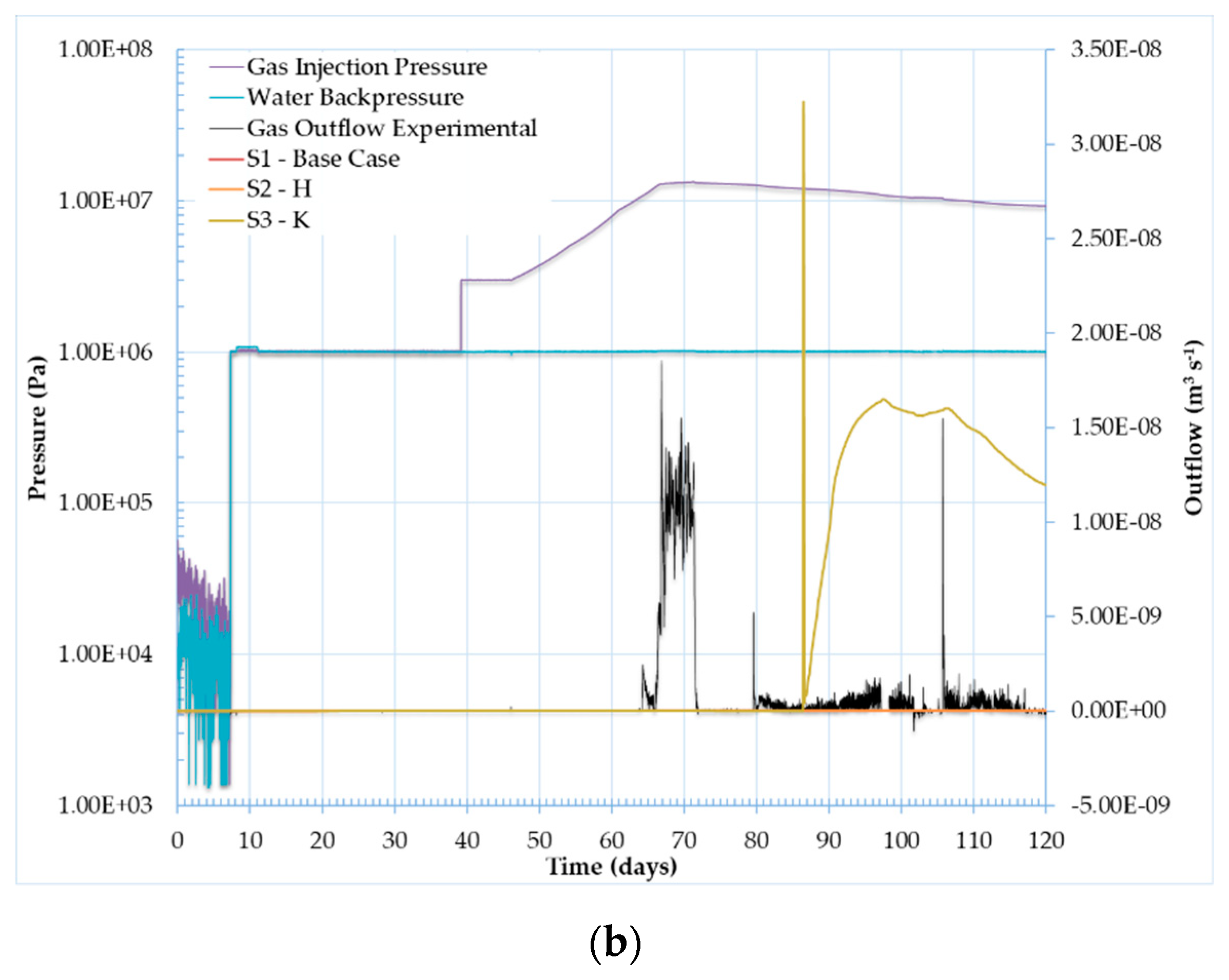
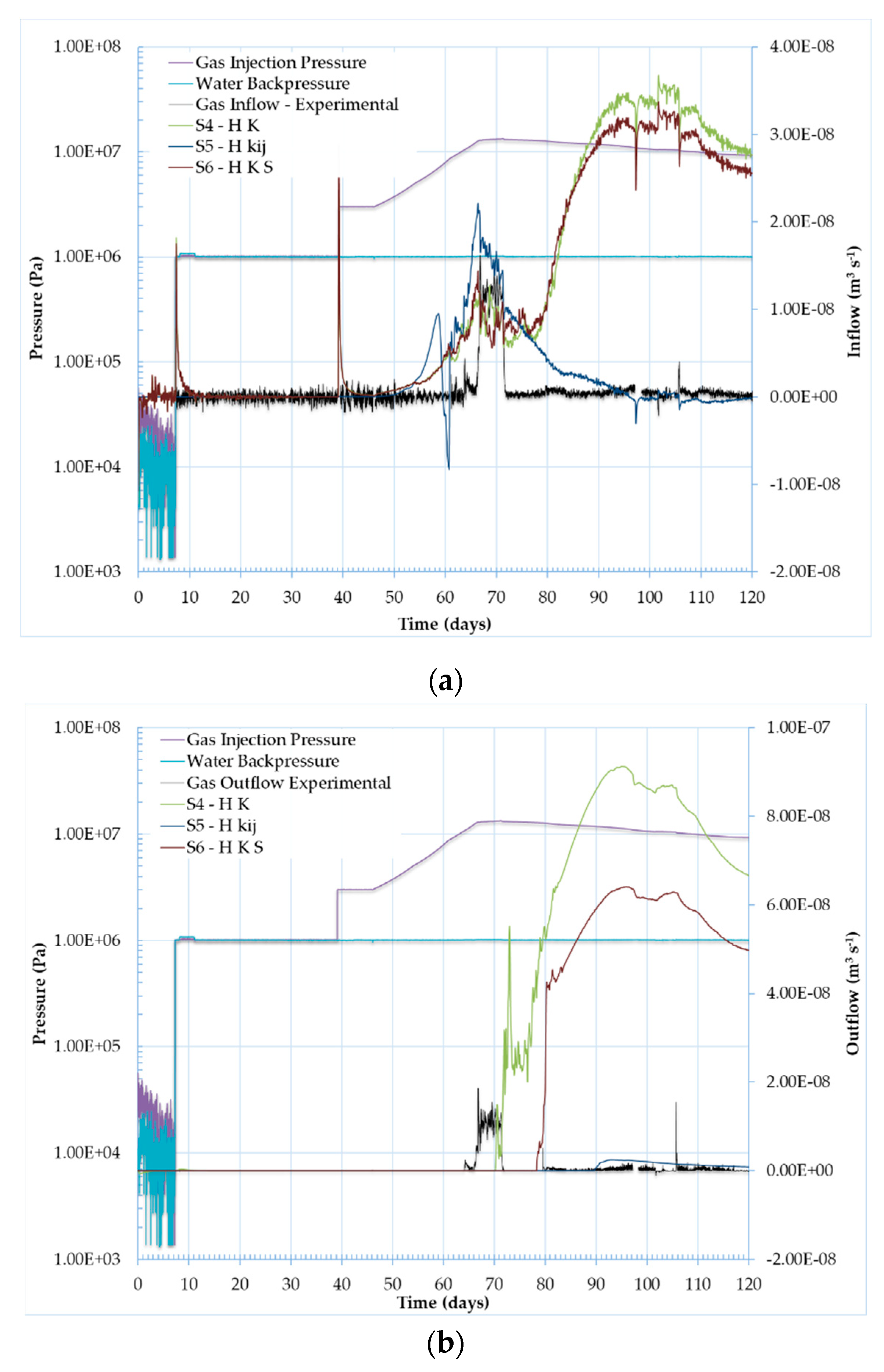
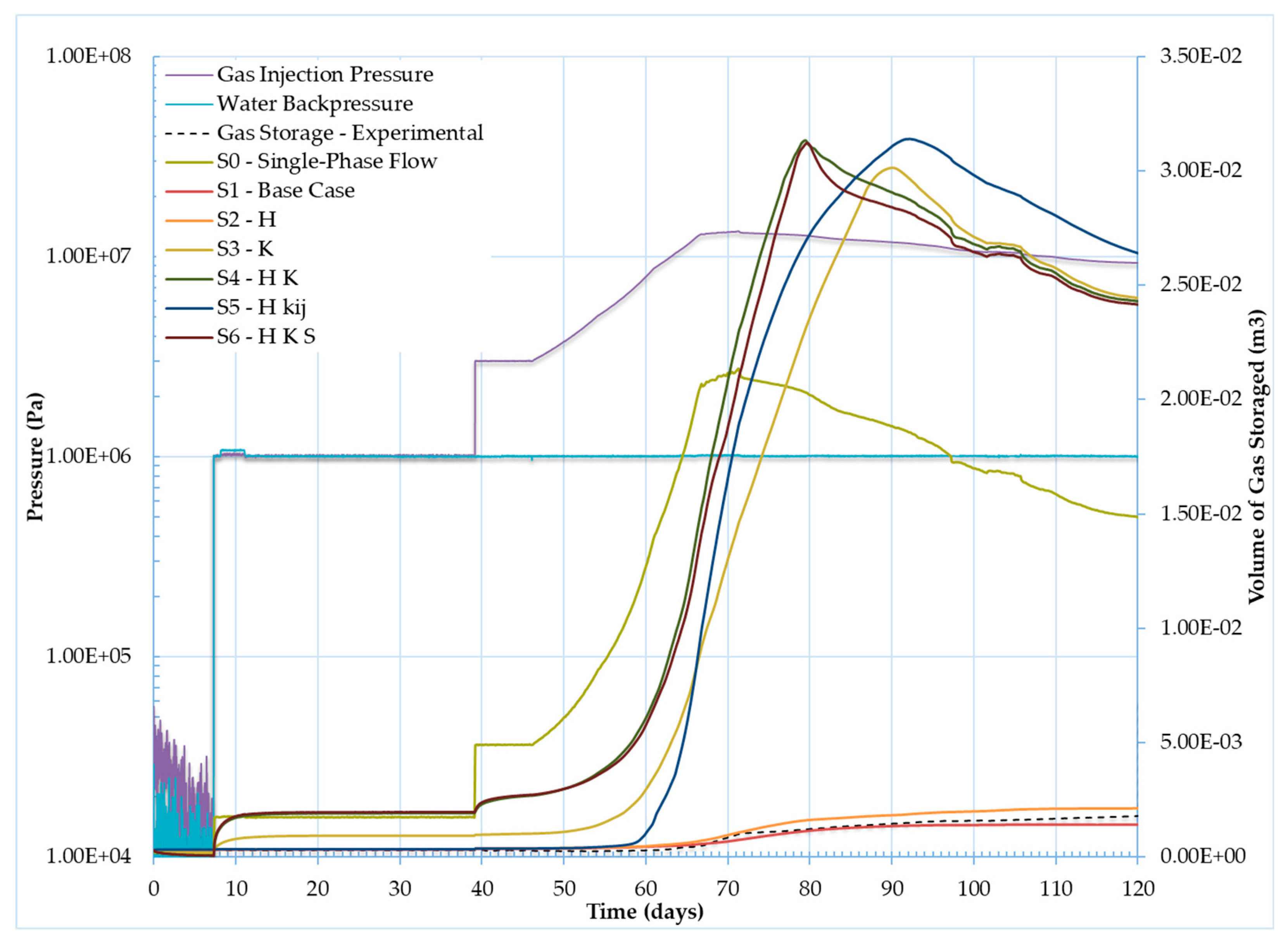
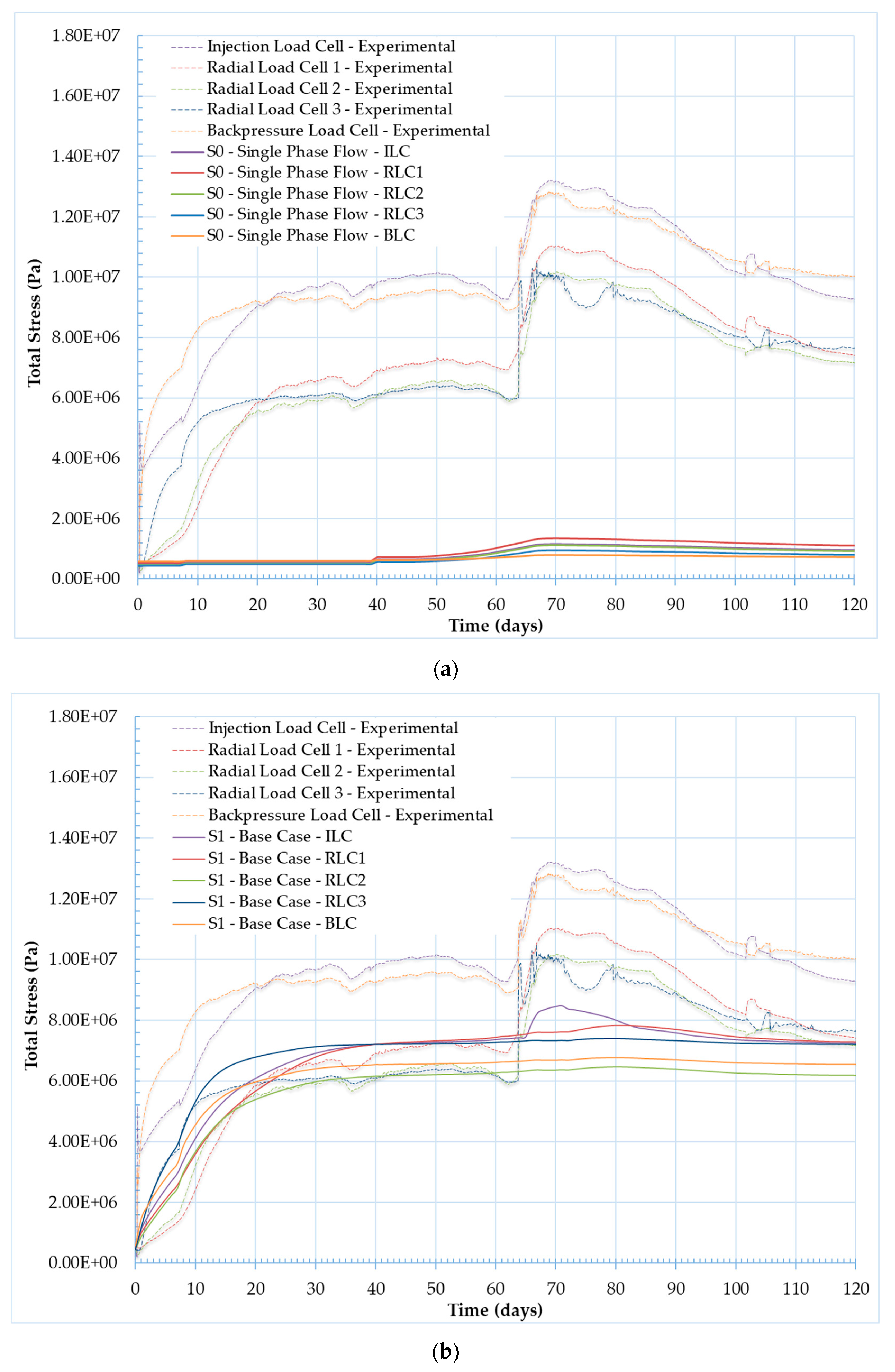

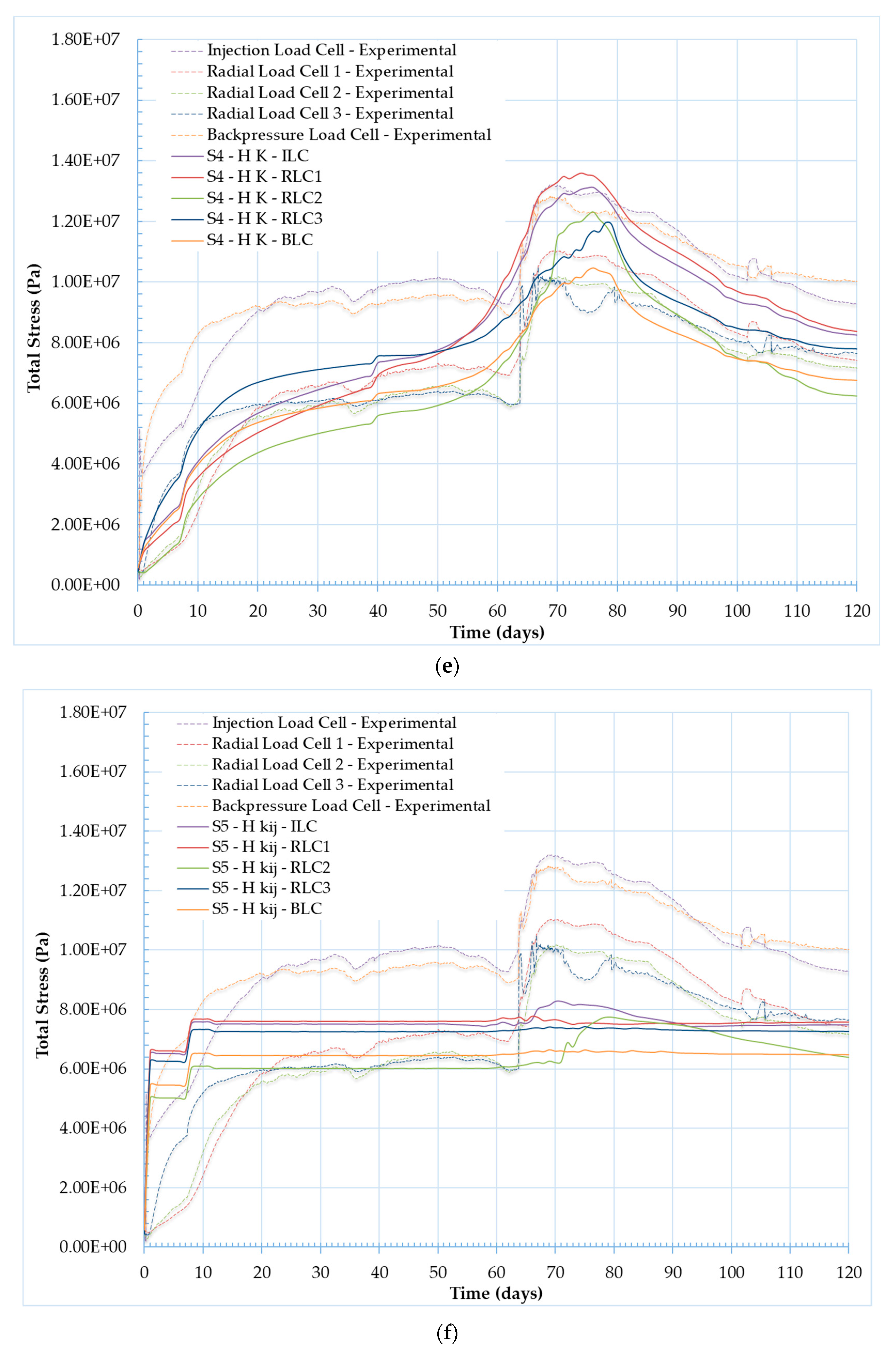
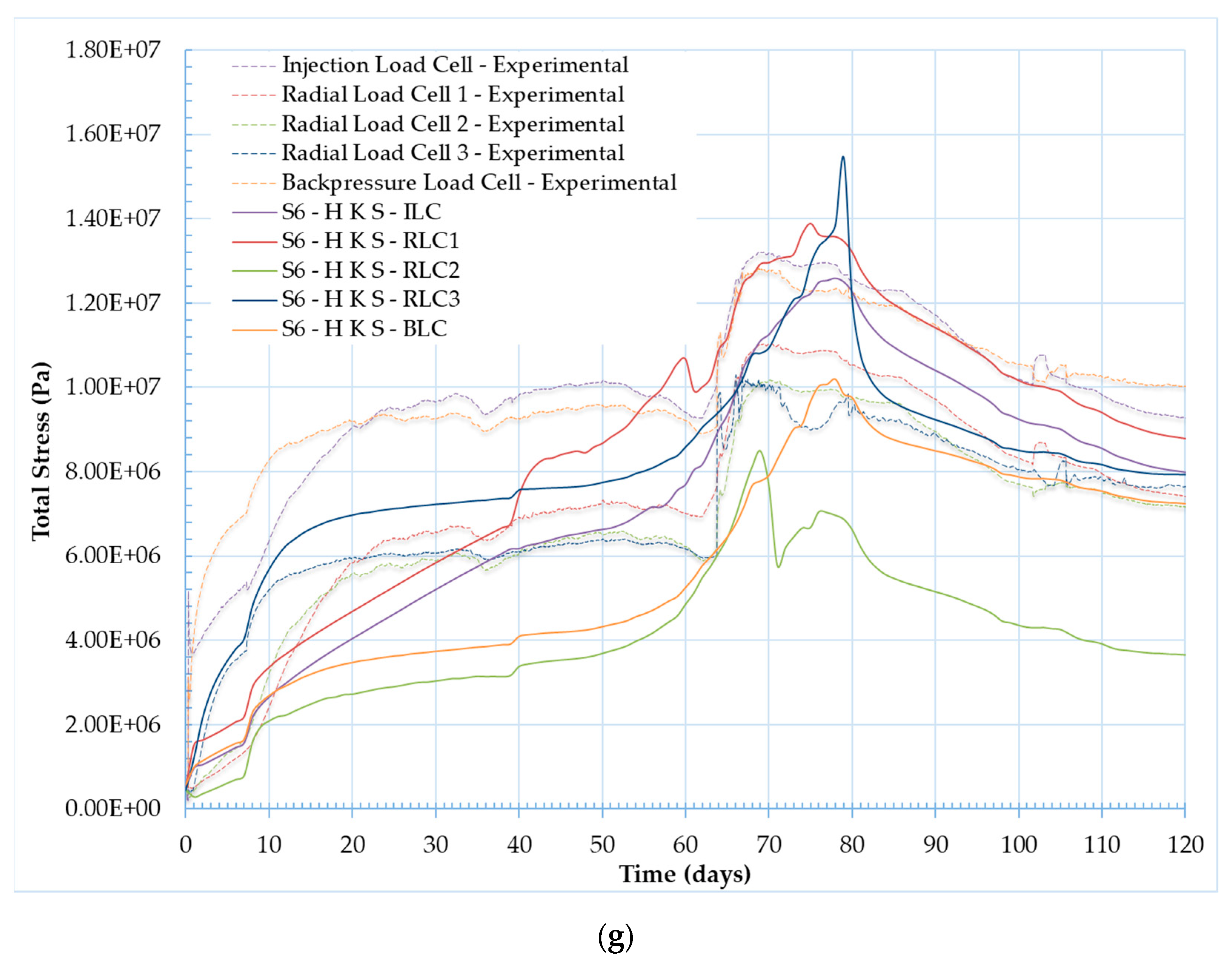
| Material | Parameter Name | Symbol (Units) | Value |
|---|---|---|---|
| Solid Soil Matrix (MX-80 Bentonite) | Young’s modulus | (MPa) | 307 |
| Poisson’s ratio | (-) | 0.4 | |
| Initial porosity | (-) | 0.44 | |
| Intrinsic permeability of water | (m2) | 3.4 | |
| Dry density | (kg m−3) | 1560 | |
| Saturated degree of saturation | (-) | 1 | |
| Residual degree of saturation | (-) | 0.05 | |
| Bulk modulus of bentonite | (Pa) | 5.0 × 108 | |
| Volume–surface mean diameter | (m) | 1.50 × 10−9 | |
| Pore radius | (m) | 1.50 × 10−8 | |
| Tortuosity [11,34] | (-) | ||
| Gas (Helium) | Density of helium | (kg m−3) | (1) |
| Dynamic viscosity of helium @ 293.15 K | (Pa s) | 2.0 × 10−5 | |
| Bulk modulus of helium | (Pa) | (1) | |
| Henry’s coefficient for dissolution of helium in water | 0.0091 | ||
| Diffusivity of helium in water | (m2 s−1) | 6.29 × 10−9 | |
| Diameter of helium gas particle | (m) | 1.0 × 10−10 | |
| Liquid (Water) | Density of water | (kg m−3) | 1 × 103 |
| Dynamic viscosity @ 293.15 K | (Pa s) | 0.001 | |
| Bulk modulus of water | (Pa) | 2.2 × 109 |
| Parameter Name | Parameter | Initial Value Condition |
|---|---|---|
| Initial poregas pressure | 1.01 × 105 Pa | |
| Initial degree of saturation | 0.96 | |
| Initial suction (from SWCC) | 5.95 × 106 Pa | |
| Initial porewater pressure | −5.85 × 106 Pa | |
| Initial displacement field | m | |
| Initial stress | 0.45 × 106 Pa | |
| Initial gas concentration in porewater @STP | 0.073 mol m−3 | |
| Initial AEV | AEV | 1 × 107 Pa |
| Scenario Number | Purpose | Description 1 | Initial Porosity Distribution (mean ± sd) | Coefficient of Klinkenberg Effect, (-) | Initial Average Intrinsic Permeability of Water, (m2) |
|---|---|---|---|---|---|
| S0 | Single-phase flow case | Single Phase | 0.44 | 0 | 3.4 × 10−21 |
| S1 | Base case scenario | Base Case | 0.44 | 0 | 3.4 × 10−21 |
| S2 | Test if heterogeneity alone could influence preferential flow pathways or the formation of gas fingers | Introduce H | 0.44 ± 0.06 | 0 | 3.4 × 10−21 |
| S3 | Test if Klinkenberg effect could influence preferential flow pathways and contribute to gas fingering | Introduce K | 0.44 | 1 × 108 | 3.4 × 10−21 |
| S4 | Test effect of both heterogeneity and Klinkenberg effect to development of preferential flow pathways | H, K | 0.44 ± 0.06 | 1 × 108 | 3.4 × 10−21 |
| S5 | Test if Klinkenberg effect contributes to reducing number and size of gas fingers | H and | 0.44 ± 0.06 | 0 | 5.0 × 10−19 |
| S6 | Test effect of linear swelling on total stress evolution | H, K, Slinear | 0.44 ± 0.06 | 1 × 108 | 3.4 × 10−21 |
| Parameter Name | Symbol | Value | Units |
|---|---|---|---|
| Length | 0.12 | m | |
| Density of bentonite | 1526 | kg m−3 | |
| Young’s modulus | 3.07 × 108 | Pa | |
| Poisson’s ratio (nu) | 0.4 | - | |
| Porosity | 0.44 | - | |
| Intrinsic permeability | 3.40 × 10−21 | m2 | |
| Dynamic viscosity | 2.00 × 10−5 | Pa s | |
| Degree of saturation | 0.9 | - | |
| Air-entry-value | 1 × 107 | Pa | |
| Constant porewater pressure 1 | 1.0 × 106 | Pa | |
| Relative gas permeability 1 | 0.03 | - | |
| Chi factor 1 | 0.9 | - |
© 2019 by the authors. Licensee MDPI, Basel, Switzerland. This article is an open access article distributed under the terms and conditions of the Creative Commons Attribution (CC BY) license (http://creativecommons.org/licenses/by/4.0/).
Share and Cite
Dagher, E.E.; Infante Sedano, J.Á.; Nguyen, T.S. A Mathematical Model of Gas and Water Flow in a Swelling Geomaterial—Part 2. Process Simulation. Minerals 2020, 10, 32. https://doi.org/10.3390/min10010032
Dagher EE, Infante Sedano JÁ, Nguyen TS. A Mathematical Model of Gas and Water Flow in a Swelling Geomaterial—Part 2. Process Simulation. Minerals. 2020; 10(1):32. https://doi.org/10.3390/min10010032
Chicago/Turabian StyleDagher, Elias Ernest, Julio Ángel Infante Sedano, and Thanh Son Nguyen. 2020. "A Mathematical Model of Gas and Water Flow in a Swelling Geomaterial—Part 2. Process Simulation" Minerals 10, no. 1: 32. https://doi.org/10.3390/min10010032
APA StyleDagher, E. E., Infante Sedano, J. Á., & Nguyen, T. S. (2020). A Mathematical Model of Gas and Water Flow in a Swelling Geomaterial—Part 2. Process Simulation. Minerals, 10(1), 32. https://doi.org/10.3390/min10010032






